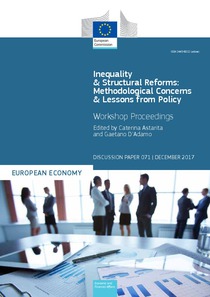Inequality and structural reforms: methodological concerns and lessons from policy - workshop proceedings
"Income inequality became more and more prominent in the academic and policy debate in recent years and particularly since the economic downturn. Inequality, indeed, may have long-term effects on (potential) growth and macroeconomic stability, reinforcing existing inequalities and reducing oppo...
| Institution: | ETUI-European Trade Union Institute |
|---|---|
| Format: | TEXT |
| Language: | English |
| Published: |
Luxembourg
2017
Publications Office of the European Union |
| Subjects: | |
| Online Access: | https://www.labourline.org/KENTIKA-19397177124911153599-inequality-and-structural-refo.htm |
| Summary: | "Income inequality became more and more prominent in the academic and policy debate in recent years and particularly since the economic downturn. Inequality, indeed, may have long-term effects on (potential) growth and macroeconomic stability, reinforcing existing inequalities and reducing opportunities, skills development and social and occupational mobility. Structural reforms, i.e. labour and product market reforms and tax-benefit systems reforms, are one of the main tools available for public interventions aimed at boosting growth while not being detrimental to equality. In this context, DG ECFIN of the European Commission organised two workshops held on the 16th of May and the 19th of June 2017 aimed at enriching the existing knowledge of the relationship between structural reforms and inequality and taking place at a time where Europe discusses the social dimension, notably the European Pillar of Social Rights as proposed by the Commission and proclaimed at the Social Summit in Gothenburg. The first workshop focused on the methodological issues whilst the second one focused on policy evidence of the impact of structural reforms on inequality. These proceedings take stock of the discussions held in the workshops, in order to contribute to the growing debate on how to better take into account distributional effects when formulating policy advice." |
|---|---|
| Physical Description: | 136 p. Digital |

